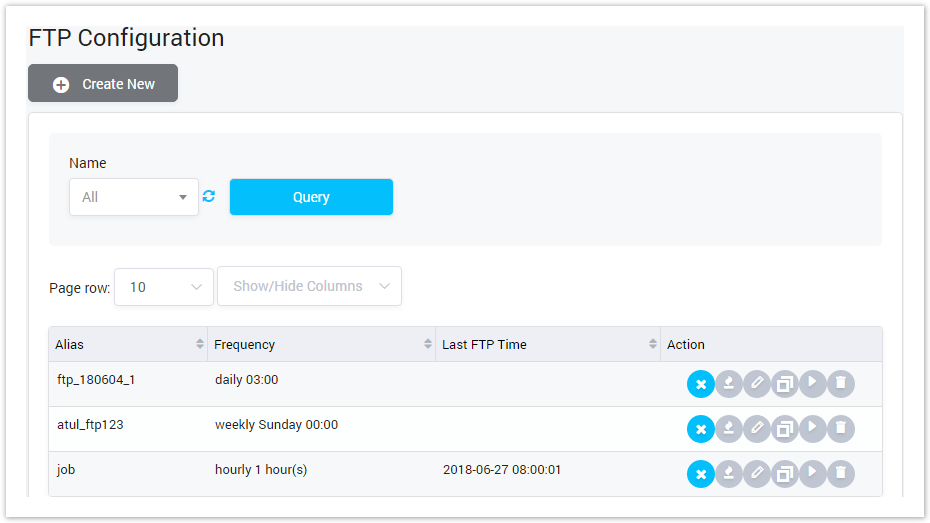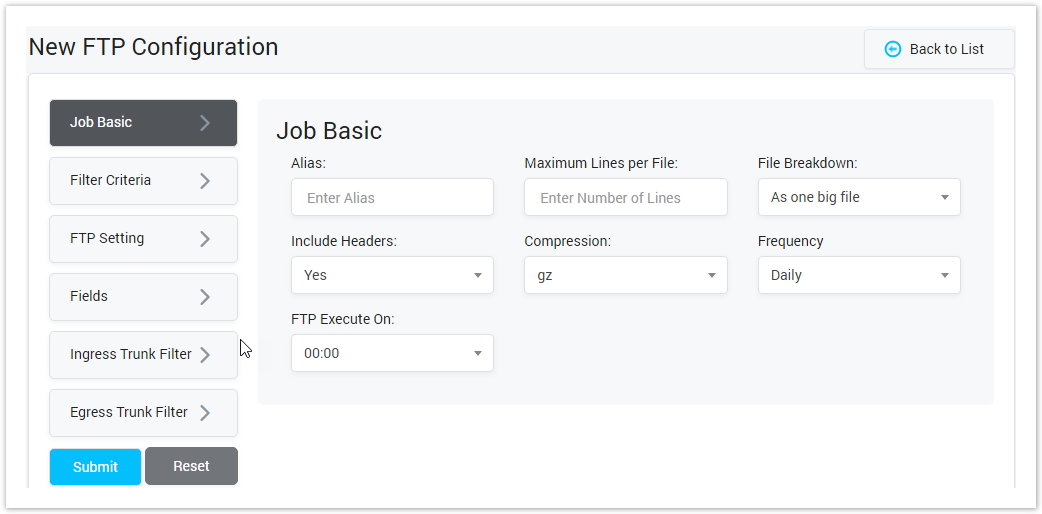| Column Name | Description |
|---|---|
| Alias | The alias of the FTP job. |
| Frequency | The schedule to execute the job. |
| Last FTP Time | The last date/time when the job was executed. |
| Action | The action performed on the FTP job. |
| Button | Description |
|---|---|
| Is used to select the name of FTP job to see details. Click on the arrow, the list of all available FTP jobs will be displayed. | |
| Is used to refresh to get latest the list of the FTP jobs. | |
| Is used to query data. Clicking on this button, the result will be displayed. | |
| Is used to set the total of records per a page. | |
| Is used to select the column which will be shown/hidden. | |
| Is used to deactivate/activate job. The inactivate job will not be executed anymore. | |
| Is used to execute job for testing. It will test all the configuration of job. | |
| Is used to edit the configuration of FTP job. | |
| Is used to clone the job. Click on this button, input name for job, the new job will be created with new name but the same setting with the original job. | |
| Is used to executed the job. | |
| Is used delete the job. | |
| Is used to go to next, previous page. It is also used to go to the specific page by clicking on the number of page. |
Adding FTP Job
To add new FTP Job, click on the Create New button, this page will be shown as below:
Screenshot: Adding FTP Job
| Field Name | Description |
|---|---|
| Job Basic | Alias: This field is used to set the Alias of FTP Job. |
| Maximum Lines per File: The switch has the ability to break down CDRs to files and upload small batch of CDRs in file one by one to the FTP server.This field to set the maximun line of CDR for a file. Ex: If you set maximum is 200.There is file with 250 lines. It will be spreated to 2 files and uploaded to server. First file has 200 lines and second file has 50 lines. | |
File Breakdown: User may want to break down the CDR into smaller truns. We have to choose the way to break down the file.
| |
| Include Headers: Send the CDR to server with headers or not. | |
| Compression: The format of CDR that will be sent to server. | |
| |
| Filter Criteria | The switch can let user to determine what CDRs to push to FTP. User can define multiple FTP server for different set of criteria. Duration: Filter data in CDR by Time Duration of call.
|
| Originating Release Cause: All the calls have release cause from Origination same the selected field will be displayed on CDR. | |
Terminating Release Cause: All the calls have release cause from Terminating same the selected field will be displayed on CDR. | |
| FTP Setting | |
| Server Port: Input the port of FTP server. | |
| Server Directory: Input the directory of FTP server where place the CDR file. | |
| Username: Input the Username to authenticate to the FTP Server. | |
| Password: Input the Password to authenticate to the FTP Server. | |
| Fields | Select the fields that will be shown in CDR. |
| Ingress Trunk Filter | Select the Ingress Trunk where get the CDR and upload to FTR Server. |
| Egress Trunk Filter | Select the Egress Trunk where get the CDR and upload to FTR Server. |
Filling in all fields, then click on Submit button to save.
Related pages
Popular Topics
Recently Updated Pages









